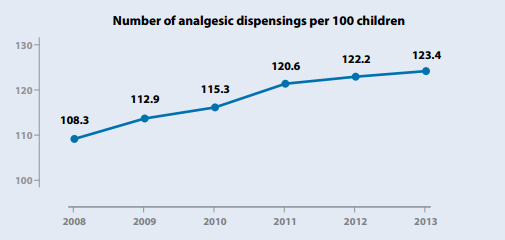In this article 
View / Download pdf version of this
article
Practical tips and information for managing pain in children
In 2013, 54% of all children aged < 12 years enrolled in general practice in New Zealand had an analgesic medicine dispensed.
Children experience pain in the same way as adults but may not have the verbal or communication skills to adequately express
the location, type and intensity of pain. This, along with a cautious approach to giving analgesia to children, can sometimes
result in pain being undertreated
- Paracetamol and ibuprofen are the most appropriate analgesics for short-term mild pain relief, while the underlying
cause of pain is managed. Combining or alternating paracetamol and ibuprofen is acceptable, but not routinely recommended.
- Paracetamol is usually first-line, and should be dosed based on the weight of the child (15 mg/kg, every 4 hours)
- Ibuprofen is the preferred non-steroidal anti-inflammatory drug (5-10 mg/kg, every 6-8 hours). Diclofenac sodium 12.5
mg and 25 mg preparations are approved for use in children aged over one year, however it is rarely used in a general
practice setting.
- If referral to secondary care is required in an acute situation, pain relief should ideally be started prior to transfer
- Morphine is the first-line analgesic for children with moderate to severe pain, e.g. trauma; the appropriate dose
(based on both age and weight) is the lowest dose which provides effective analgesia with manageable adverse effects
- Intranasal fentanyl can be considered if available
Pain in Children in New Zealand
Figure 1 below highlights the 16% increase in the use of analgesics
by children aged under 12 years from 2008 to 2013. This increase is mainly due to children receiving multiple analgesics
rather than more children receiving medicines.
Nationally
716,169 children
aged under 12 years are registered to a practice
54.2% of all registered
patients aged under 12 years received an analgesic in 2013
Sample Practice
288 children aged
under 12 years are registered to your practice
62.8% of your registered
patients aged under 12 years received an analgesic in 2013

Figure 1. The rate of analgesic dispensings for New Zealand children aged under 12 years, 2008–2013
Paracetamol is the first-line treatment for pain in children, ibuprofen is also appropriate
for children with mild pain.
Opioids are rarely indicated for mild to moderate pain management in general practice settings, although morphine,
and sometimes fentanyl, may be appropriate in acute moderate to severe pain situations, e.g. trauma.
The use of opioids in children has increased 77% between 2008–2013.
Aspirin is contraindicated in children aged under 16 years but continues to be prescribed to this age
group.
Table 1 below shows the number of patients receiving each of the top six analgesics dispensed to
children aged under 12 years nationally in 2013 and the comparative rates for your practice.
Sample Practice Data
Dispensing of analgesics to children registered at Sample Medical Centre
| Analgesic |
Nationally
Number of patients |
% |
Sample Practice
Number of patients |
% |
| Paracetamol |
367,626 |
94.7% |
176 |
97.2% |
| Ibuprofen |
128,289 |
33.0% |
46 |
25.4% |
| Codeine phosphate |
3,939 |
1.0% |
0 |
0.0% |
| Diclofenac sodium |
706 |
0.2% |
1 |
0.6% |
| Aspirin |
342 |
0.1% |
0 |
0.0% |
| Tramadol |
287 |
0.1% |
0 |
0.0% |
Table 1. Number of children receiving the top six analgesics during 2013, nationally and in your practice (from any prescriber).
The percentage shown is the proportion of children who received each analgesic, e.g. 95% of all children who received one
or more analgesics received paracetamol.